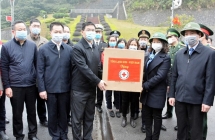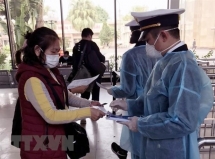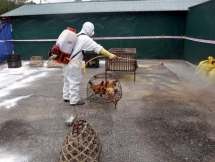China turns to hi-tech, big data in fight against coronavirus
| Vietnam's Lang Son province assists Chinese region in nCoV fight | |
| Visitors come from or transit in China’s nCoV-hit areas to be quarantined | |
| Agriculture ministry requests boosting avian flu fight |
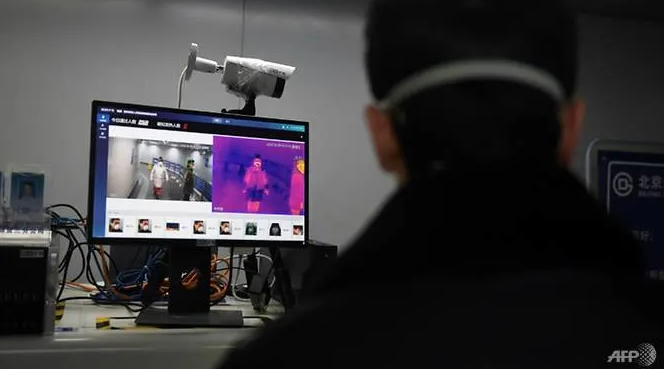 |
| An AI-powered system developed by Megvii screens commuters for fever at a metro station in Beijing. (Photo: AFP/GREG BAKER) |
As Chinese authorities race to contain the spread of a new virus, which has infected more than 30,000 people and killed more than 600 in China, Beijing is turning to a familiar set of tools to find and prevent potential infections: data tracking and artificial intelligence, AFP reported.
Several Chinese tech firms have developed apps to help people check if they have taken the same flight or train as confirmed virus patients, scraping data from lists published by state media.
Residents monitor the entrance to a compound in Beijing. Some neighbourhoods are prompting residents
In Guangzhou, southern Guangdong province, robots at one public plaza have even been deployed to scold passersby who are not wearing masks, according to the state-run Global Times.
And in Beijing, one neighbourhood committee responsible for an apartment complex of about 2,400 households said they used flight and train data to keep track of everyone's recent travel record.
"Use big data technology to track, screen priority (cases), and effectively forecast the development of the epidemic in real time," China's National Health Commission (NHC) told local governments in an online statement Tuesday.
"Strengthen the information link between... public security and transportation, and other departments," it said, urging them to share train, flight, communication, and medical data.
FEVER TECH
As Chinese authorities search for potential infections, a point of focus has been detecting fevers, a common symptom of the disease.
While neighbourhoods and office buildings rely primarily on hand-held thermometers, public transport hubs are also trialling fever detection systems that use artificial intelligence and infrared cameras.
In Beijing, a system developed by Chinese search giant Baidu screens travellers at the Qinghe railway station using infrared and face detection technology, which automatically photographs each person's face.
If someone has a body temperature of 37.3 degrees Celsius or above, the system sets off an alarm - prompting a secondary check by station staff.
On Thursday, railway personnel, clutching red-and-white megaphones, ordered passengers arriving from northern Shanxi province to slow down as they passed by Baidu's system.
According to the company, its system can check more than 200 people a minute, far faster than the thermal scanners used at airports.
Megvii, an AI firm that was blacklisted by the US in October over alleged rights abuses, has developed a similar system, which is currently being used at a subway station in Beijing.
"Having a team of nearly 100 people working together remotely from home hasn't been easy," said a spokesperson at Megvii in an emailed statement.
"All of them are working around the clock during Lunar New Year public holidays," said the company, adding that the team had to optimise its models to "effectively detect temperature with only the forehead exposed."
FIVE MILLION TRAVELLERS
Besides fever detection, Chinese tech firms have raced to develop a wide variety of services to help with epidemic control efforts, from preparing drone deliveries of medical supplies to mapping the spread of the virus from Wuhan.
Although the city has been under effective quarantine since Jan 23, some five million travellers left Wuhan during the Lunar New Year festival, according to the city mayor - galvanising a nationwide search for recent Wuhan visitors.
Still, the majority of tracking carried out by local authorities in China requires a lot of manpower, though some are entering data online to help with registration, especially as residents return after the holiday.
In Beijing, some neighbourhoods are prompting residents to scan a QR code to fill out personal details, such as their phone number and hometown address.
One form also prompted participants to fill out details on their mode of transport, such as their licence plate or flight number, if they had travelled.
It also asked if they had "recently" visited central Hubei province - where Wuhan is located - or come into contact with anyone from the hard-hit region.
| 86 people died in a single day in China on Friday. The coronavirus death toll now stands at 724, and all but two of those died in mainland China. Globally, the virus has infected more 34,400 people across 27 countries and territories. A 60-year-old US national died in Wuhan Thursday, the US Embassy in Beijing said Saturday, marking the first confirmed death of a foreigner. Japan also reported its first death of suspected coronavirus in Wuhan on Saturday. At least three more passengers have tested positive for the Wuhan coronavirus, according to a statement released by the Japanese Ministry of Health on Saturday, bringing the total number of cases on the Diamond Princess cruise ship to 64. At midnight Saturday, authorities in Hong Kong began imposing 14 days' quarantine for all travelers arriving from mainland China. Five more people have tested positive for the coronavirus in France, Health Minister Agnes Buzyn said Saturday, bringing the total number of cases in France to 11. |
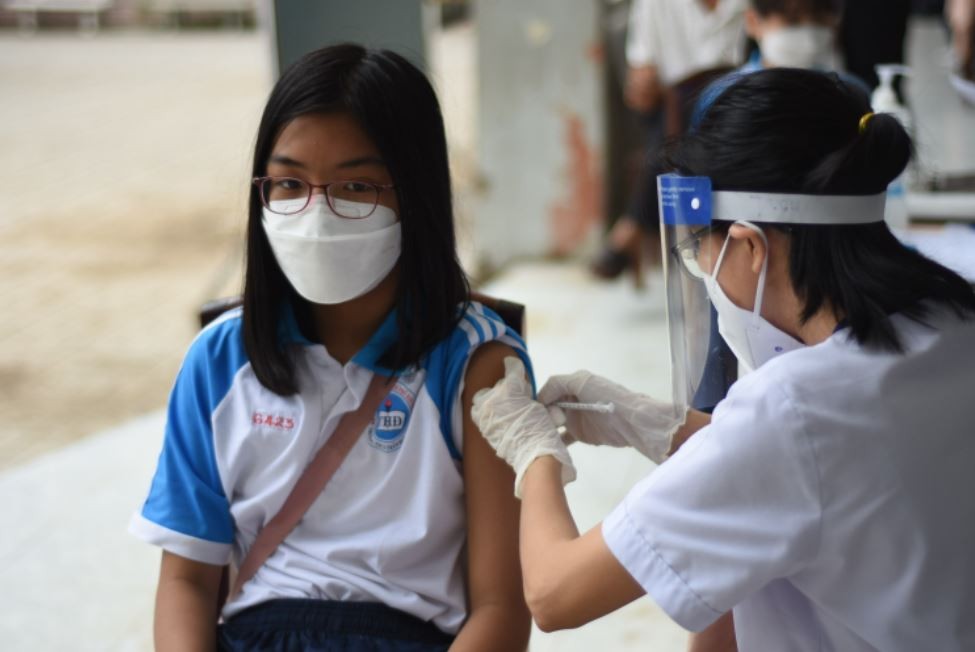 Focus
Focus
Vietnam Covid-19 Updates (May 1): Daily Infections Fall to Nine-month Low of 5,109
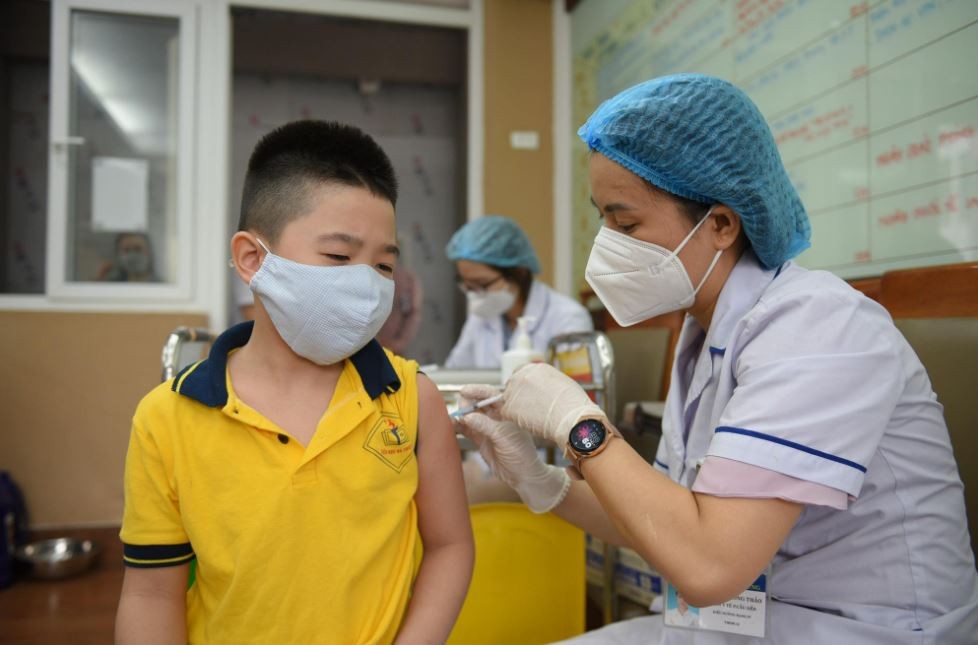 Focus
Focus
Vietnam Covid-19 Updates (April 29): 7,100 Cases, 79,000 Recoveries Reported
Recommended
 World
World
Pakistan NCRC report explores emerging child rights issues
 World
World
"India has right to defend herself against terror," says German Foreign Minister, endorses Op Sindoor
 World
World
‘We stand with India’: Japan, UAE back New Delhi over its global outreach against terror
 World
World
'Action Was Entirely Justifiable': Former US NSA John Bolton Backs India's Right After Pahalgam Attack
 World
World
Nifty, Sensex jumped more than 2% in opening as India-Pakistan tensions ease
 World
World
Easing of US-China Tariffs: Markets React Positively, Experts Remain Cautious
 World
World
India strikes back at terrorists with Operation Sindoor
 World
World

